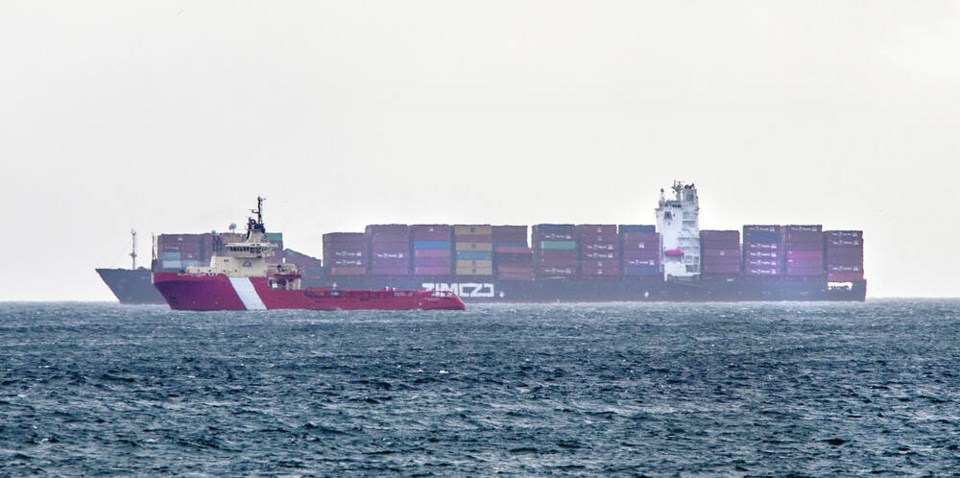Removing 60 containers damaged by fire and rough weather aboard the cargo ship Zim Kingston could take up to 12 days and involve multiple salvage contractors, and safety and regulatory agencies, says the Port of Nanaimo.
The 260-metre Zim Kingston, which spilled 109 containers off Vancouver Island and saw other cargo catch fire in late October, left its anchorage at Constance Bank off Victoria on Friday, headed for Nanaimo with about 2,000 containers aboard.
The vessel will remain at anchor off Protection Island near Nanaimo for about a week before a berth and dock area is prepared next Friday, and cranes can start manoeuvring containers off the vessel, said Ian Marr, chief executive of the Port of Nanaimo.
“It’s definitely an interesting job that’s ahead of us,” Marr said.
The Zim Kingston had been anchored at Constance Bank for 40 days after a fire ripped through several containers — some carrying hazardous materials — and forced the evacuation of the ship’s crew.
Prior to its arrival, the ship had listed in heavy seas at the entrance to the Strait of Juan de Fuca on Oct. 21-22, spilling 109 containers into the Pacific Ocean. Four containers broke up and washed onto north Island shores, littering beaches with debris ranging from refrigerators and sofas to Christmas decorations and school supplies.
The Zim Kingston’s trip from Constance Bank to Protection Island was expected to take 11 hours at a speed of eight knots.
The vessel was flanked by the Canadian Coast Guard, a pair of tugs and other vessels with environmental and marine-mammal specialists.
A salvage company hired by the ship’s owner, Greece-based Danaos Shipping Co., was on board to monitor container stability during transit and provide firefighting capacity if needed, the coast guard said.
Damaged containers and other debris will be offloaded in Nanaimo. The Zim Kingston is then expected to proceed with its remaining containers to the Port of Vancouver.
Satinder Singh, Port of Nanaimo vice-president of marine operations, said unloading the Zim Kingston will be a careful, lengthy process. The ship has undamaged overhanging containers that will have to be offloaded and stacked before crane operators can safely reach the damaged ones in two areas of the ship where fires broke out.
Salvage crews have identified at least 58 damaged containers, but more will likely have to be offloaded and inspected, with some returned on board.
Singh wasn’t sure how many workers will be involved, but said the team will include salvage crews and contractors from the ship’s owner, officials from Canada Customs, Transport Canada and government environmental bodies, and crews from the port’s operator, DP World, who would operate cranes and provide logistics and safety measures on land and around the water, as well as stewardship of the vessel.
Marr said all of the damaged containers be will put into a designated area, opened and inspected to determine what can be salvaged. “The materials will be sorted and any disposal debris would be identified and assessed for disposal according to environmental standards.”
He said where the debris ends up will likely be decided by the Environment Ministry.
A total of 105 containers, including two carrying a hazardous substance used in the mining industry, are still missing and believed to have sunk. The Canadian Coast Guard said it continues to work with Danaos Shipping Co. to investigate whether it’s feasible to locate the missing containers.
In total, 27,360 kilograms of debris had been removed from Island beaches as of Friday, which doesn’t include five large waste bins still at Jurassic Point, site of the final beach cleanup.
The coast guard said the ship’s owner will continue to check known accumulation sites for debris every few months and remove debris likely to be from the Zim Kingston. Coast guard crews are also checking for debris when doing regular flights over the area.
Anyone who spots marine debris is asked to report it to the Canadian Coast Guard by calling 1-800-889-8852.
Nanaimo’s port has deep water able to accommodate ships of Zim Kingston’s size, while Vancouver’s port — backlogged at the best of times — is now squeezed by a shortage of trucks and flooding-related closures of major transportation corridors.
Marr said the Port of Nanaimo has been at capacity at its Duke Point site and is working with the City of Nanaimo in its official community plans about acquiring more industrial land to expand the port.
With reports that the Port of Vancouver is reaching capacity because of industrial land shortages, Nanaimo is an increasingly viable site for goods being shipped to the west coast, said Marr.
“Part of our plan has always been to increase resiliency for Vancouver Island, so the Island can look after itself in terms of the goods we need,” said Marr, adding last month’s flood damage is a reminder of how supply chains can be disrupted.
- - -
To comment on this article, email a letter to the editor: [email protected]



